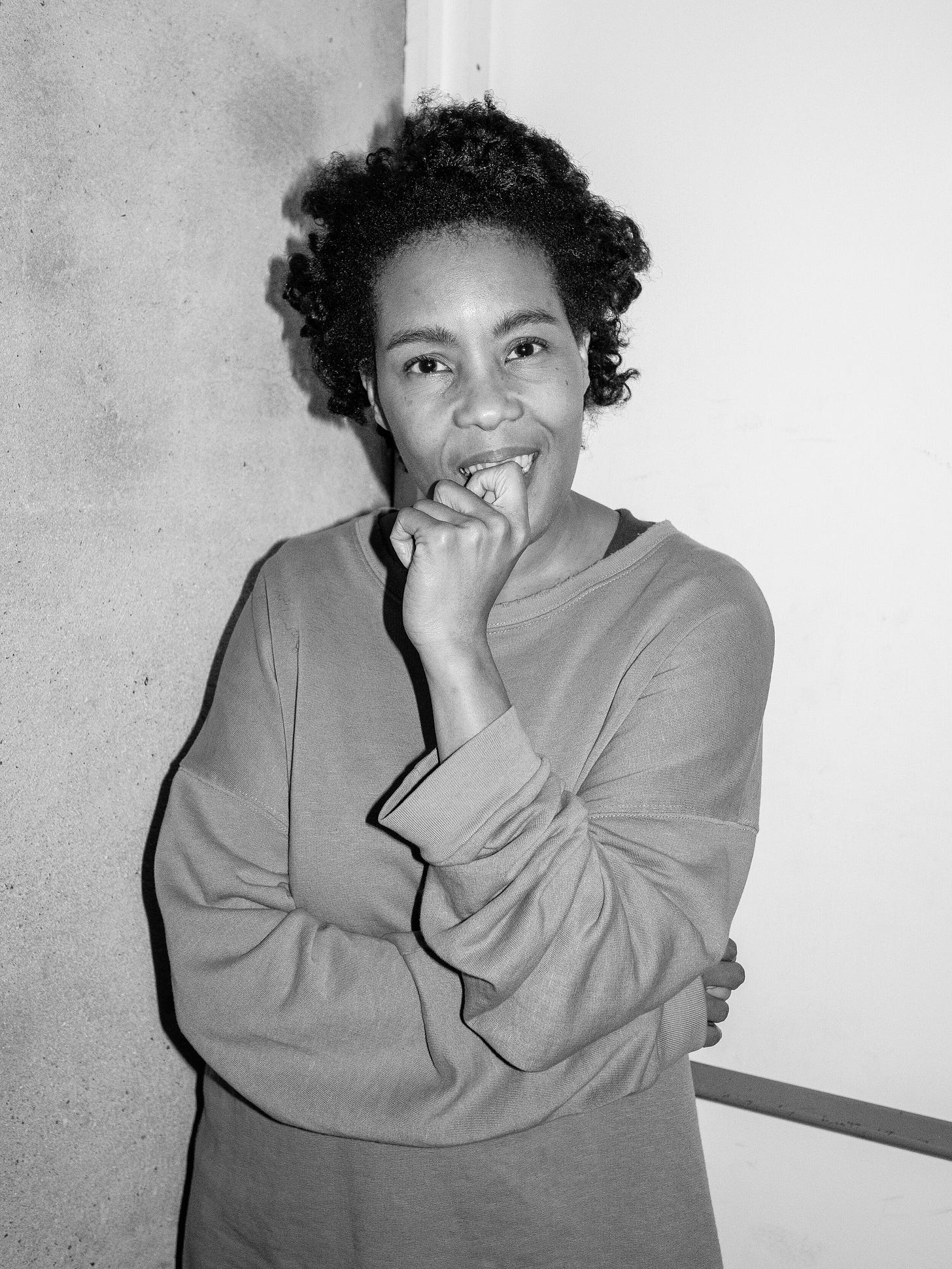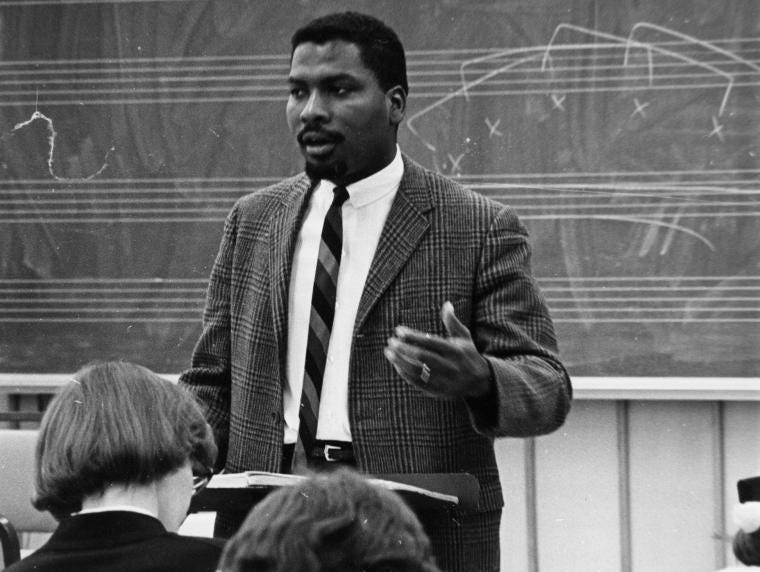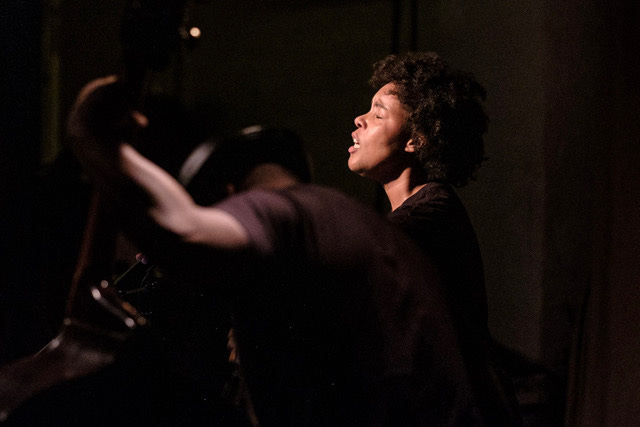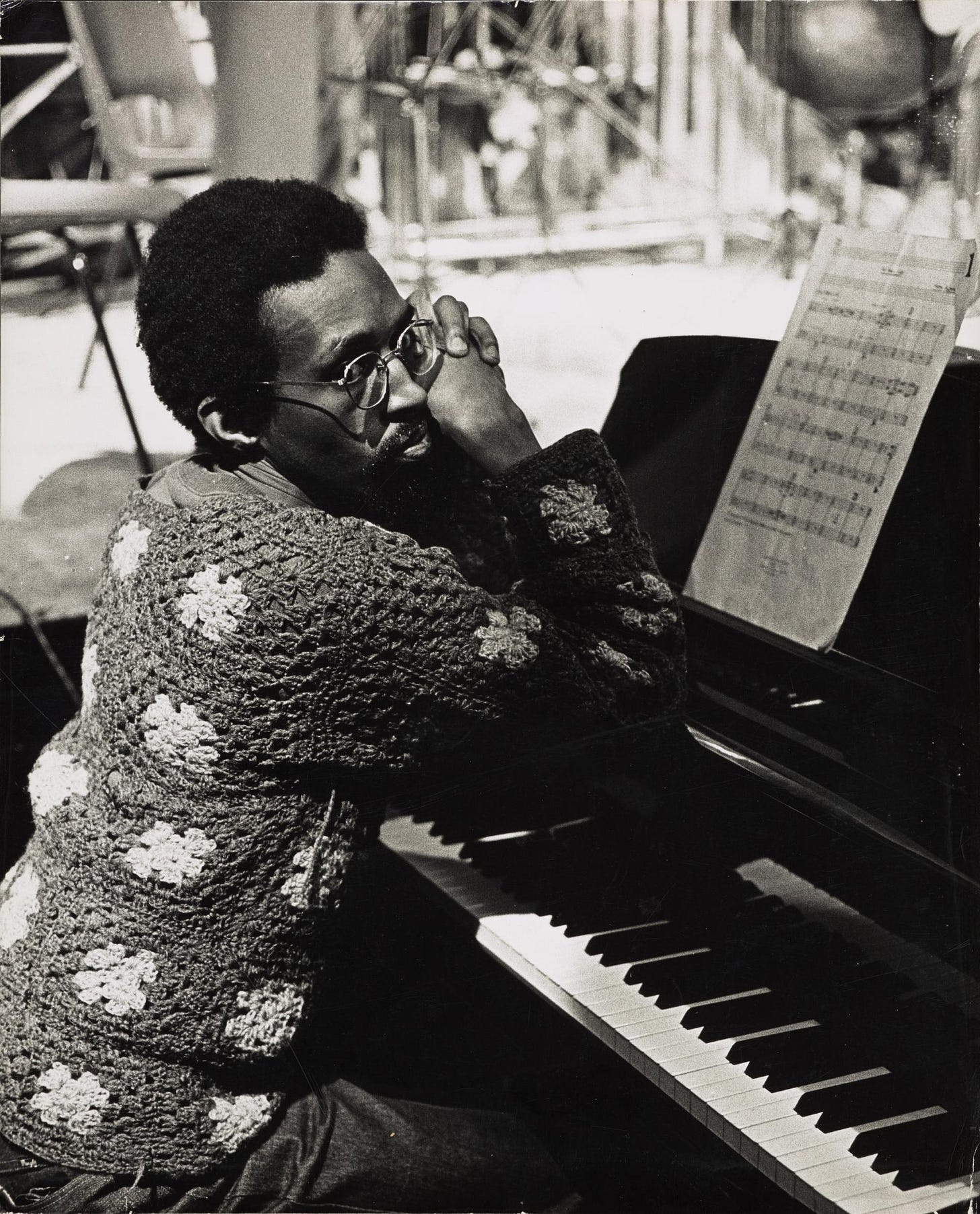black radical – 19 February 2025
the future is now: an interview with elaine mitchener
Michelle Kambasha
on third spaces, the limits of language and dismantling the notion that black artistic expression is linear and in the distance.
I’ve been clear with myself from the beginning that I wanted this Substack to interweave education, openness, and complete enjoyment—to take me (and you) in directions we might not have thought to explore on our own. A bit like going on Skyscanner and searching ‘Anywhere’ as your destination.
Last summer, I developed a broad interest in composition. But rather than just understanding it through the narrow lens of Western traditions, I wanted to grasp the full breadth of the discipline. So, I did what most of us do: I Googled. And despite the many sins of the internet—and Google as a corporation—it’s still remarkable what a simple search can unearth.
A couple of hours of study led me to Elaine Mitchener, an artist whose interdisciplinary practice feels intrinsic to her very being. She’s an experimental vocalist, a movement artist, a composer—her work spanning improvisation, contemporary music theatre, and performance art. It is confronting, unshy, and otherworldly—the kind of otherworldliness that draws you into her artistic lair, and once you leave, your mind, brain, and entire outlook on art are transformed.
Her practice is deconstructive in its own right and some of it actively seeks to dismantle Black lives and legacies as they have been historically framed. Her gasps, warbles, and stammers act as vocal metaphors for painful histories; her fidgets, slaps, and sharp cuts speak to something similar—a physical and sonic excavation of memory, trauma, and endurance.
This is especially palpable in her album Solo Throat. Here, the voice is not just an instrument but an archive, a living testimony. It is stretched, fragmented, pushed to its extremes, becoming a site of resistance and reinvention. In listening, you don’t just hear—you witness.
What’s particularly compelling to me is how her practice upholds and transforms the work of Black composers before her—figures like Jeanne Lee, Eric Dolphy, Archie Shepp, and Joseph Jarman who were radical in their own right. Through projects such as Vocal Classics of the Black Avant-Garde and all that are under the banner of Elaine Mitchener Projects, she reinterprets and extends their legacies, refusing to let them be static relics of the past.
Then, there’s her engagement with Julius Eastman. Eastman, a singular force in 20th-century minimalism, was often sidelined by the very institutions that now herald his brilliance. Mitchener’s interpretations of his work are not just revivals; they are reanimations—deeply felt, deeply embodied. She doesn’t just perform Eastman; she channels him, amplifies his radical vision, and folds it into the present moment. (On April 3rd, Mitchener premieres Moving Eastman at the Barbican)
Elaine Mitchener is, in many ways, a bridge—between past and present, sound and movement, Black radicalism and avant-garde experimentation. And in following her work, I find myself not just learning about composition but rethinking what music, performance, and storytelling can truly be.

(July 11th 2024)
Michelle Kambasha: Thanks for speaking with me. I really appreciate your time—I know you’re busy, so I won’t keep you long.
Elaine Mitchener: That’s absolutely fine.
Could you walk through your background—your childhood, musical influences, and how they shaped your path?
I grew up in London’s East End. My parents are Jamaican immigrants. My brother was into Funkadelic and jazz-funk, while my dad loved reggae, ska, and gospel. I started with the recorder at school and discovered classical music through watching ballet on TV—I even wanted to be a dancer. Pop music was there too, but I wasn’t deeply tied to any specific group or band.
Church was transformative. I saw incredible young Black musicians—peers who could play, sing, and lead. I was in an all-girls singing group, and we weren’t just performing; we were organising rehearsals, arranging music, and curating performances. It was leadership training without me realising it.
Church as a third space—beyond home and school—is such a formative environment for many Black people. .
Absolutely. The church nurtured both talent and responsibility. Elders, many working modest jobs during the week, led music programs or health initiatives on weekends. I remember a DIY music school run by a man from Trinidad—no fees, just learning. He taught theory and piano, and older kids mentored younger ones. One of my friends now runs a similar program in South London, passing on the legacy.
That early access to music feels vital, especially now with school programs disappearing.
Exactly. Community spaces like that were lifelines. Social media now spotlights talents like the Kanneh-Masons, but I grew up seeing families just as gifted playing every Sunday in church. The UK gospel scene may be small compared to the U.S., but it’s brimming with talent.
The U.S. gospel industry feels massive—so different from our grassroots community scene.
I remember seeing footage from a U.S. gospel camp—five kids under 16 on drum kits, jamming together with incredible skill. It was raw, electric—pure joy in performance. We need more of that here.
Also, group performances like that build discipline and musicianship. Many famous artists started in church choirs. And when school contributed, it was often a Black-majority school with a strong music program—those programs are fading fast due to cuts.
Nina Simone’s story comes to mind—her teacher nurtured her classical talent, but racism blocked her from the concert pianist career she deserved.
Nina Simone’s story is both inspiring and tragic. Racism denied her the concert pianist career she deserved, but you can hear her classical training—especially Bach—in her improvisations. Her journey reminds me how crucial access to music education is. I was lucky—school covered my lessons—but when Thatcher’s government cut music funding, many lost that opportunity. Youth centers, churches, and community groups became lifelines. But what if you’re a Black child without access to those spaces? I had a supportive teacher who encouraged me—despite my unlikely choice of the flute! My parents, though supportive, were wary of a music career. Coming from Jamaica, they knew how unstable that life could be—my dad even sang for tourists, something I only learned later.
Their concerns weren’t misplaced. Just today, I read a quote from visual artist Hew Locke in The Guardian:
“We live in a precarious universe. Artists are like antelopes in the Serengeti—we can smell danger in the air.”
In the arts, times change quickly. Today’s star can be tomorrow’s afterthought. My parents hoped for stability—a lawyer, a doctor—but music was always my path.
It’s such a familiar story. My parents, coming from Zimbabwe, valued security above all. Creativity felt risky, and rest was never an option.
In working-class Black families, survival meant pushing forward. At college, I watched privileged classmates take gap years without worry. In my world, no one rested—everyone hustled. That urgency never leaves you; it shapes everything you do.
It’s funny—like my mum used to joke when she came to this country. She’d notice English women with their tiny baskets, just a few chops and two potatoes. Meanwhile, Black women were hauling trolleys piled high with heavy-duty food—rice, oil—carrying multiple bags with that familiar look of exhaustion. But it wasn’t just Black women; women of color carried that same load. You realise that moving countries doesn’t change your ways—it’s what you know.
It was always heavy bags!
Rest isn’t just stillness—it’s about joy, even in activity. Like a Black grandmother cooking a big meal—not out of duty, but because it brings her joy.
Exactly. Rest is about alignment—doing what feels intuitive and fulfilling.
I saw that yesterday. I twisted my ankle, so I was resting. My mum, tired herself, disappeared into the kitchen and returned with a plate of food, smiling. Feeding us wasn’t a chore—it was her joy, her version of rest.
That’s it—rest as nourishment, not a trend. Just something natural.
EM: Yes! I told friends on Tuesday, “I’m taking the day off,” and they said, “Good! You need it!” It felt right to give my brain space—though, ironically, I twisted my ankle the next day! Freelancing makes carving out rest so hard.
“The essence of Africanness consists of a way of doing something, not simply something that is done” – Composer, Olly Wilson

I wanted to ask you about how your passion for exploring Black avant-garde music, Black composition, and under-recognised works by Black artists influences your creative practice. You’ve mentioned in past interviews—particularly when you discovered the work of Olly Wilson—that you were surprised and a bit embarrassed that you hadn’t encountered his music sooner. You described it as an incredible experience to uncover such impactful work during your artistic journey.
How does this process of discovery—finding artists and composers you weren’t aware of despite your deep engagement with music—shape your approach to creating and researching? Does it inspire you to seek out more of these hidden voices within the landscape of Black musical expression?
Yeah, absolutely. In the world of making and performing music, you often meet other musicians and artists who introduce you to names you hadn’t encountered before. Sometimes you realise, “Oh, that person was Black, or Asian, or a woman.” But for me, it always starts with the music—if it’s interesting and sparks something in me, I’ll dig deeper.
There are so many artists waiting to be rediscovered, but there have always been people quietly championing their work. Take Julius Eastman—everyone talks about him now, but when I was in music college in the late ’90s, I already knew of him, thanks to Mary Jane Leach. She’s a fantastic composer herself, but she also took it upon herself to archive Eastman’s work—without payment, simply out of love and respect for his artistry. She shared his scores online so anyone could perform them. That kind of generosity is rare, especially in such a competitive field.
Mary Jane later faced criticism, especially around the pandemic, when more people started latching onto Eastman’s legacy. But the truth is, he wasn’t some fringe figure—people shared bills with him, heard his voice, and still never mentioned his name. It’s a reminder of how easily important artists can be forgotten.
As a performer, part of my job is to champion the work I love and present it to new audiences. That’s why performing Olly Wilson’s music at Tectonics in May was so meaningful to me. Afterward, I received emails from British composers—people I respect—saying, “Thank you for introducing me to Olly Wilson. I love his work and am eager to hear more.” Moments like that remind me why I do this—to discover, celebrate, and share music that deserves to be heard.

For sure. I really liked what you said about these artists being rediscovered—because stories like Julius Eastman’s are often framed as “lost tapes” narratives. But as you pointed out, his work was being performed, just not always in spaces where white audiences were present. So when it’s suddenly “found,” it feels like a colonialist trope—discovered only when it reaches certain spaces, despite always existing in others.
I get what you’re saying, but with Julius Eastman, his work was more often performed by white musicians. What we’re seeing now is more of a reclaiming by Black artists—though “latching on” isn’t quite the right phrase.
The truth is, there aren’t many Black classical musicians working in experimental or contemporary new music, at least not in the way I do. There are more emerging, but few have performed Eastman’s work—and with good reason. They’ve been focused on writing and performing their own music, creating their own paths.
So, it’s not that Eastman’s work was entirely forgotten—it’s more that his career fell out of favor, as often happens to composers. I think of someone like Hugh Locke—once celebrated, now less visible. Eastman was hidden in plain sight.
His name should have remained alongside composers like Steve Reich, Philip Glass, John Luther Adams, or Meredith Monk—whom he performed with. Yet, over time, his voice was marginalised. He should have been recognised as part of that canon, not outside of it.
“What I am trying to achieve is to be what I am to the fullest: Black to the fullest, a musician to the fullest, a homosexual to the fullest.” – Julius Eastman

So, would you say it’s less about rediscovery and more about reclamation of his work by a small but growing group of contemporary Black composers trying to spread and uphold his work? Is that a fair way to frame it?
Yes, broadly. There are ensembles performing his work—like Davóne Tines, a brilliant African American singer and composer, who’s very thoughtful about his programming. Then there’s the Otolith Group, who made a film around Eastman’s piano pieces, which I was involved in.
But ultimately, it’s about who’s in charge of programming. Aside from Toks Dada at the Southbank Centre, I can’t think of many Black or Brown music programmers at major concert halls. If they’re out there, I’d love to know, because I’d applaud their work. But without diverse gatekeepers advocating for this music, it won’t reach wider audiences.
I know how this works firsthand—I used to work in classical music publishing. I’ve seen how hard it is to get these conversations started. For example, Eastman’s Second Symphony is going to be performed at the Proms, which is fantastic, but I know how difficult those conversations were behind the scenes.
Right, and I think that ties back to your point—these conversations are hard-won, and even when they happen, there’s a fear: How long will this interest last? Will it be another case of a composer rising to prominence, only to fade into the background again—a flash in the pan, “flavor of the month” moment—before the conversation shifts elsewhere?
We’ve all seen it. Take the push for 50/50 gender balance in programming—there was a moment where it was all about women composers. Or the initiatives around able-bodied and disabled artists performing together.
Then came the Black Lives Matter movement, which accelerated discussions that had been going on for years. It forced institutions to make decisions—and we’re still feeling the effects of that push. But trends can change quickly.
That’s why something like Composing While Black is so important. As George Lewis says, this isn’t the conclusion—it’s just chapter one. Some people treat works like this as if they’re the final word on the subject, like, Okay, it’s written down, let’s move on. But Lewis is reminding us: No—this is only the beginning.
Totally. It’s why scholarship—especially from ethnomusicologists—is so vital. Books are an important currency in the world we live in. I was reading about Dr. Antoinette Handy—are you familiar with her?
No, I’m not.
She was an ethnomusicologist and violinist who wrote several books, including Black Women in American Orchestras, which I think was published in the ’50s or ’60s. A person I work with, Sultana Isham—a composer and scholar—introduced me to her work. The Handy sisters, as I understand it, were both deeply involved in music and scholarship, though much of their writing is now out of print. You’d probably have to pay hundreds for a copy.
But it makes me think about the importance of acknowledging existing scholarship that often gets buried or overlooked—research that only people with the time and resources, like PhD students, end up uncovering. It directly informs the literature we see today and helps preserve Black musical histories.
Absolutely. Books like that help reframe narratives and ensure they’re part of the record. I didn’t know about Dr. Antoinette Handy, but what’s interesting is that she was an ethnomusicologist writing about Black women in orchestras. And that’s the thing—because it’s classified as ethnomusicology, it gets sidelined.
Ethnomusicology has historically been treated as a study of “other” music—implying that it exists outside the so-called Western classical tradition. But that “other” music often predates the Western canon. It’s a frustrating label because it reinforces a hierarchy that shouldn’t exist.
Yes! I struggle with the limitations of language too. I often describe my work as “uncovering Black alternative stories,” but I always feel the need to clarify that “alternative” doesn’t mean alternative to whiteness. It’s just a term that helps me communicate what I do. But even in using that term, I worry that the work itself will get othered.
I get that. It’s a valid concern, but it’s also something we can’t let hold us back. We should just do the work.
Why and how did you choose your repertoire, or the way that you write and perform?
The truth is, I went through music college performing standard classical repertoire, and while I could sing it well, those stories didn’t move me. Opera, for example—I love hearing others perform it, but it just didn’t resonate for me.
Contemporary and experimental music, on the other hand, challenged me musically and creatively. Improvisation, which I’m known for, felt natural because it allowed me to draw from everything that has influenced me. I love that my work isn’t easily categorised. I can perform Berio, John Cage, Julius Eastman, Olly Wilson, Ben Patterson, Yoko Ono, or a living composer like Joel Feigin, whose opera I’m currently performing in. There’s no hierarchy—I just bring it all together because I can.
It sounds like what keeps you excited is discovery—finding new influences and channeling them into your work. Your music isn’t confined to a single tradition; it merges everything you’re passionate about. That must feel incredibly gratifying.
Yes, and recently social media, for all its faults, has surfaced things that have blown my mind. Videos of traditional dances from East or West Africa. When I watch them, I think: This is avant-garde. It’s been happening for millennia, and it was always the future—the rest of the world is just catching up. It’s part of why I feel conflicted about the term Afrofuturism. I think people misunderstand it—it’s not about imagining a distant future. It’s about understanding that the future has always been here. Black artistic expression has never been linear—it bends, folds, and expands across time.
Take contemporary music by African diasporic composers.. Even when they work within what seems like a formal, Western classical framework, there’s always a glitch—something unexpected. I call it a glitch because it pushes the music somewhere new, somewhere beyond the expected form. It could be a rhythmic shift, a tonal surprise, or a reference that reshapes everything.
And now, we’re seeing a generation of artists performing this work with deep knowledge of that lineage. It’s inspiring. And you can’t hold it back—it’s already loose in the world.
Yes, and a lot of my recent reading has been about Black radical traditions of Afrofuturism—how they merge to create futures centered on Black experience. It’s fascinating how these ideas cross disciplines—music, poetry, visual art—and influence each other. You embody that in your practice, drawing from multiple artistic forms to shape your sound.
Exactly! I’m so sorry you missed the residency—it was a real experiment, bringing together different constellations of artists. I had my “house band” of Pat Thomas, Neil Charles, and Mark Sanders, plus violinist Mandhira de Saram. I also invited artists I admire—some I knew, others I was curious about—pairing them in combinations they’d never played in before – Jay Bernard, Roy Claire Potter, Tamica Ruddock, and GAIKA.
I was performing a text from N.H. Pritchard’s Gyre Galaxy, repeating fragmented phrases. The audience didn’t know the poem, but they felt it—like Pritchard was in the room.
Each night ended with a big group improvisation, and on the first night, the energy was electric—like church, but rawer. People were shouting and screaming at the back of Café OTO—something I’ve never seen there. – It could’ve been a total car crash—but it worked!
I actually spoke with Gaika a month ago—such an interesting artist, especially with his blend of music and visual art. I imagine he was a perfect addition to your lineup.
Gaika is so politically engaged, and like many of us, refuses to be boxed in—I really admire that. At the residency, Jay Bernard performed their album live for the first time, with Neil Charles on bass. The bass shifted the texture, opening up a new space for Jay’s expression.
Afterward, Jay told me they’d always wanted to sing like that but never had the right space. That’s exactly why I created the residency—to give artists room to experiment without limits.
We can’t be pigeonholed. Freedom to cross disciplines and blend approaches keeps the fire burning and the work evolving. Resting on our laurels? That’s not a luxury we have.
How does this all relate to your recent album?
Abby Thomas, who produced it, first heard me read N.H. Pritchard live and asked if I’d like to do a solo album. I’m not usually a studio artist, but with her encouragement, I went for it.
It’s a text-based work using Pritchard, Kamau Brathwaite, Una Marson, and Aimé Césaire. I didn’t include liner notes because I want people to listen without direction—just experience it and draw their own conclusions.
The album was built from layered improvisations. I overdubbed everything—track after track—without much editing. It’s raw, fresh, and exactly how I felt in the moment.
I love how you’ve merged your broader creative practice with the studio process without being boxed in by it. I imagine that was important for you—to preserve the spontaneity of how you usually create live, but in the studio.
Absolutely. I treated the studio like a live gig—imagining an audience—because that’s how I got through it. I find studios to be dead spaces; it’s hard to feel excited without the energy of a crowd, even if it’s just reading the vibe from their faces—blank stares and all!
Typical London crowd—blank faces, yep!
The project also allowed me to express visually—I created the album artwork, but funnily enough, the artwork came before the music.
I made it during a residency in Berlin, where I was exploring graphic scores for a commissioned piece. A friend from Apartment House, who’s also an artist, suggested I try painting—no pressure, just as an extension of my handwriting. “Don’t censor yourself,” he said. So, I did.
I listened to a lot of music while painting—especially a live Fela Kuti concert in Berlin from 1977. It’s brilliant. Fela was speaking on issues that still feel so relevant—overturning Western misconceptions of Africa with humor and sharp critique.
I kept laughing, especially during the dancers’ segment—imagining the stiff, white German audience’s discomfort. Fela’s message—like, they’re not dancing for you; they’re dancing for themselves—resonated with me, especially after living in Berlin for a year and witnessing the city’s political shifts.
I painted rhythmically, without form—letting internal and external rhythms guide me. I don’t use brushes, just objects and colors. I realised painting, for me, is a form of rest—intuitive, restorative, and deeply connected to my music.
That’s beautiful—how painting became its own kind of rhythm and rest for you, but still deeply tied to your music. It’s inspiring how your creative process flows across mediums without boundaries.
Thank you. For me, it’s all connected—music, painting, performance. It’s about finding a space where I can follow my instincts and let the work lead me.
Well, it’s been such a pleasure hearing about your process and the layers behind your new work. I can’t wait to see where your explorations take you next.
Connect with Elaine + upcoming performances
Elaine Mitchener MBE @ElaineMitchener1
www.elainemitchener.com
Projects & Performances:
Debut Album SOLO THROAT
Cafe Oto Otoroku label
22 Feb & 1 March
Wigmore Hall premiere broadcast BBC Radio 3 New Music Show
2 March
Moor Mother presents: Time Frequencies Cafe Oto, London
8 March
Duo w/Pat Thomas
Curious Ear Presents (St Margaret’s Church, Manchester)
3 & 4 April 2025
Moving Eastman (London Premiere), Barbican
